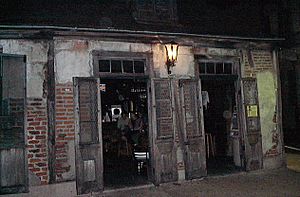Pierre Lafitte facts for kids
Quick facts for kids
Pierre Lafitte
|
|
|---|---|
| Born | 1770 Possibly France or Biarritz
|
| Died | 1821 |
| Piratical career | |
| Type | Privateer, blacksmith, spy |
| Rank | Captain |
| Base of operations | New Orleans |
| Battles/wars | War of 1812 Battle of New Orleans |
Pierre Lafitte (1770–1821) was a well-known figure in the Gulf of Mexico during the early 1800s. He was involved in privateering, which was like being a government-approved pirate, and also in smuggling goods. Pierre owned a blacksmith shop in New Orleans, which was his legal business. He was the older brother of the more famous Jean Lafitte.
Even though Pierre wasn't as much of a sailor as his brother, he was very good at dealing with people. He was known for his charm and wit, especially when selling smuggled items. Pierre also worked as a spy for Spain and led groups that used cannons. He passed away in 1821 near Dzilam de Bravo, located on the Yucatán Peninsula.
Pierre Lafitte's Early Life
Details about Pierre Lafitte's early life are not very clear. His brother, Jean, gave different stories about where he was born, mentioning places like Saint-Malo and Brest, France. Some historians believe the Lafitte brothers might have been born in the French Caribbean colony of Saint-Domingue (now Haiti).
It was common for French families from Saint-Domingue to move to the Mississippi River Delta in the late 1700s. Records show families named Lafitte in Louisiana as early as 1765. One theory suggests that Pierre, his younger brother Jean, and their mother moved from Saint-Domingue to New Orleans in the 1780s.
Another idea about Pierre's childhood comes from a different book. It says he was born near Pauillac, France. His father was also named Pierre Lafitte. This account suggests Pierre later joined his father's trading business. In 1802, Pierre Lafitte asked for a passport to go to Louisiana to meet one of his brothers. He likely left Saint-Domingue in 1803 as the Haitian Revolution became more intense.
Pierre's ship arrived in New Orleans, which was then a Spanish territory. In 1803, he tried to buy property in New Orleans but couldn't afford it. Later that year, Louisiana became part of the United States. In 1804, Pierre moved to Baton Rouge, Louisiana, which was in Spanish-controlled West Florida.
Barataria and the War of 1812
Pierre Lafitte and his brother Jean played a role in defending Louisiana during the War of 1812. Pierre is mentioned in several stories about the Battle of New Orleans. For his help in this battle, President James Madison officially forgave Pierre for his privateering activities on February 6, 1815.
After the United States bought Louisiana in 1803, new laws made it hard for New Orleans merchants to trade with foreign countries. Pierre and Jean Lafitte looked for a new place to smuggle goods. They chose a small island called Barataria, located in Barataria Bay. This spot was perfect because it was far from U.S. naval bases.
Ships could easily bring in goods without being seen by customs officers. Workers would then transfer the goods onto smaller boats called pirogues. These smaller boats would travel through the bayous to New Orleans.
Jean Lafitte claimed to have thousands of men, and he offered them to help in the Battle of New Orleans in 1815. This greatly helped Andrew Jackson fight off the British attack. While Jean likely commanded fewer men, their skill with cannons was very important. General Jackson learned about the Lafittes' bravery from Colonel Peter Ellis Bean.
Jean was more involved with the ships and sailing, while Pierre handled the business side of their operations. Pierre lived in New Orleans and managed the sales of smuggled goods. Jean spent most of his time in Barataria, organizing the privateers and the smuggling. One of the most valuable items they smuggled was enslaved people, especially after the international slave trade was outlawed in the U.S.

In 1810, a Spanish ship carrying enslaved people was captured. The enslaved people were then sold in Louisiana. Pierre Lafitte was appointed a deputy marshal to help find and recover these enslaved people. He received a portion of the money from their sale. Some historians believe Pierre did this to disrupt other slave traders who weren't working with the Lafitte brothers.
Galveston Operations
After Jean Lafitte left New Orleans around 1817, Pierre stayed in the city. However, he often visited his brother on the island of Galveston, Texas.
While the Lafitte brothers ran their operations in Galveston, they worked with Jim Bowie on the trade of enslaved people. The Lafittes would sell enslaved people, and Bowie would buy them. He then used a legal loophole to make it seem like he had "found" these enslaved people from smugglers. This allowed him to legally resell them to buyers.
Pierre Lafitte also spied for Spain through agents in Cuba and Louisiana. The Lafitte brothers often worked with both American and Spanish sides. They always focused on what was best for their own interests. Pierre's charm and reputation helped him gain trust from his contacts, even though higher-ranking Spanish officials never fully trusted him. While running the Galveston operation for their own benefit, Pierre Lafitte even tried to convince Spain to attack the island. He hoped this would improve his standing with Spain without causing much harm to the Lafitte business.

